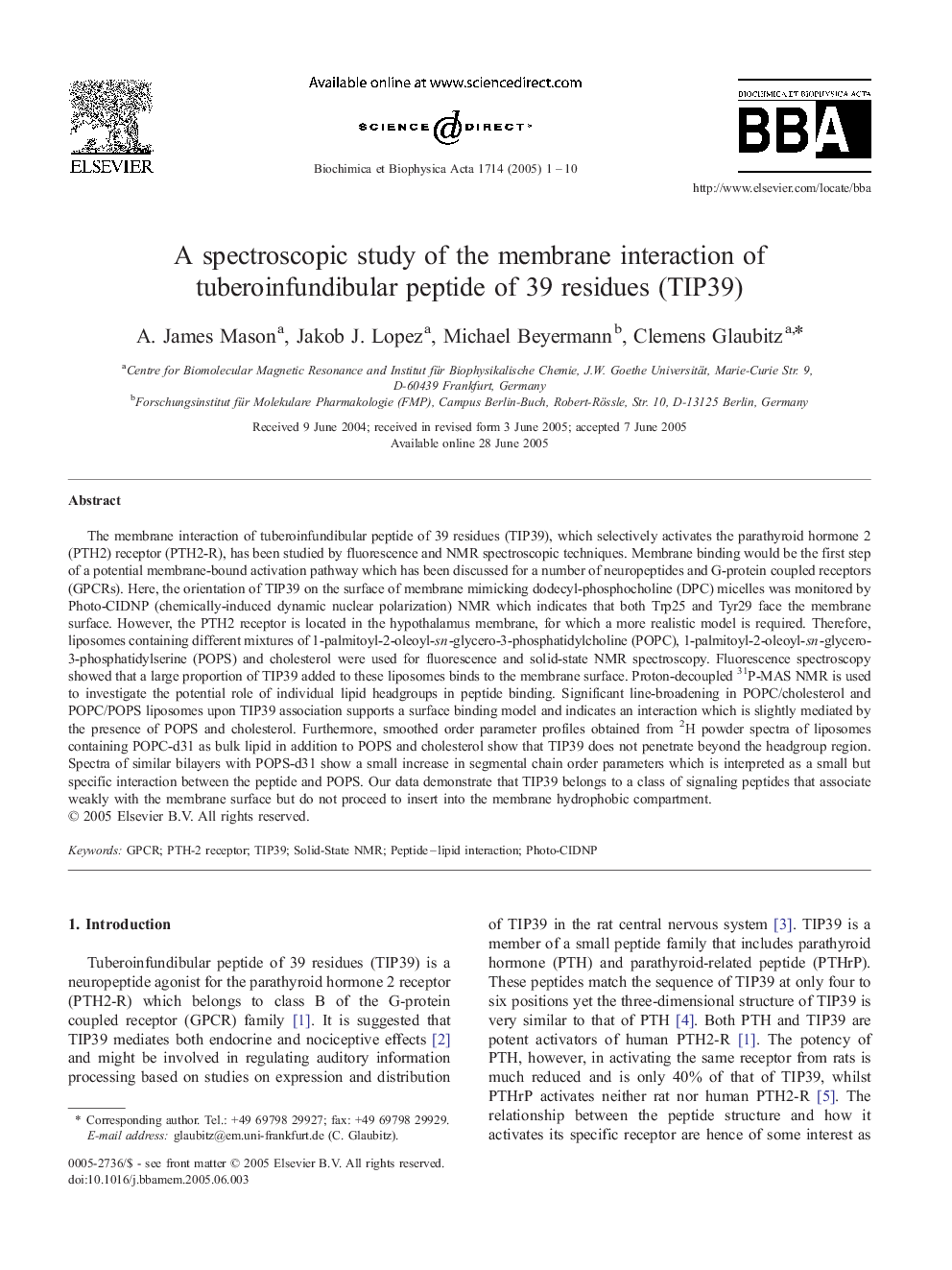| کد مقاله | کد نشریه | سال انتشار | مقاله انگلیسی | نسخه تمام متن |
|---|---|---|---|---|
| 10798158 | 1053302 | 2005 | 10 صفحه PDF | دانلود رایگان |
عنوان انگلیسی مقاله ISI
A spectroscopic study of the membrane interaction of tuberoinfundibular peptide of 39 residues (TIP39)
دانلود مقاله + سفارش ترجمه
دانلود مقاله ISI انگلیسی
رایگان برای ایرانیان
کلمات کلیدی
موضوعات مرتبط
علوم زیستی و بیوفناوری
بیوشیمی، ژنتیک و زیست شناسی مولکولی
زیست شیمی
پیش نمایش صفحه اول مقاله

چکیده انگلیسی
The membrane interaction of tuberoinfundibular peptide of 39 residues (TIP39), which selectively activates the parathyroid hormone 2 (PTH2) receptor (PTH2-R), has been studied by fluorescence and NMR spectroscopic techniques. Membrane binding would be the first step of a potential membrane-bound activation pathway which has been discussed for a number of neuropeptides and G-protein coupled receptors (GPCRs). Here, the orientation of TIP39 on the surface of membrane mimicking dodecyl-phosphocholine (DPC) micelles was monitored by Photo-CIDNP (chemically-induced dynamic nuclear polarization) NMR which indicates that both Trp25 and Tyr29 face the membrane surface. However, the PTH2 receptor is located in the hypothalamus membrane, for which a more realistic model is required. Therefore, liposomes containing different mixtures of 1-palmitoyl-2-oleoyl-sn-glycero-3-phosphatidylcholine (POPC), 1-palmitoyl-2-oleoyl-sn-glycero-3-phosphatidylserine (POPS) and cholesterol were used for fluorescence and solid-state NMR spectroscopy. Fluorescence spectroscopy showed that a large proportion of TIP39 added to these liposomes binds to the membrane surface. Proton-decoupled 31P-MAS NMR is used to investigate the potential role of individual lipid headgroups in peptide binding. Significant line-broadening in POPC/cholesterol and POPC/POPS liposomes upon TIP39 association supports a surface binding model and indicates an interaction which is slightly mediated by the presence of POPS and cholesterol. Furthermore, smoothed order parameter profiles obtained from 2H powder spectra of liposomes containing POPC-d31 as bulk lipid in addition to POPS and cholesterol show that TIP39 does not penetrate beyond the headgroup region. Spectra of similar bilayers with POPS-d31 show a small increase in segmental chain order parameters which is interpreted as a small but specific interaction between the peptide and POPS. Our data demonstrate that TIP39 belongs to a class of signaling peptides that associate weakly with the membrane surface but do not proceed to insert into the membrane hydrophobic compartment.
ناشر
Database: Elsevier - ScienceDirect (ساینس دایرکت)
Journal: Biochimica et Biophysica Acta (BBA) - Biomembranes - Volume 1714, Issue 1, 1 August 2005, Pages 1-10
Journal: Biochimica et Biophysica Acta (BBA) - Biomembranes - Volume 1714, Issue 1, 1 August 2005, Pages 1-10
نویسندگان
A. James Mason, Jakob J. Lopez, Michael Beyermann, Clemens Glaubitz,